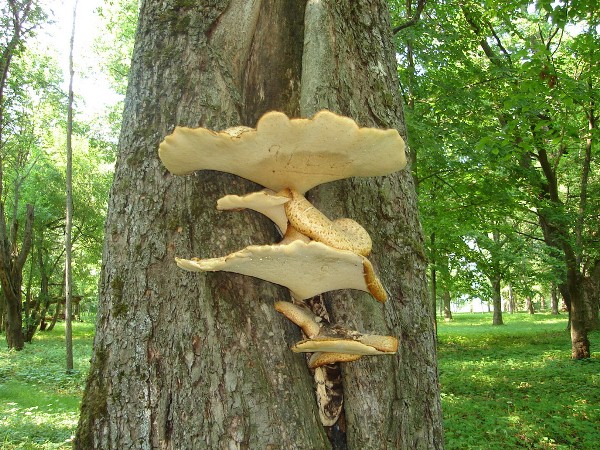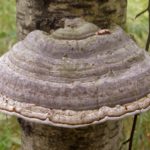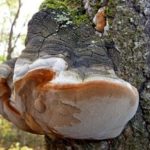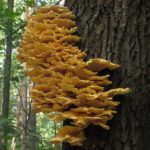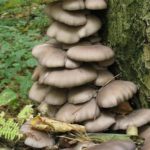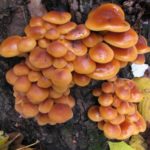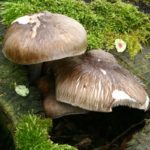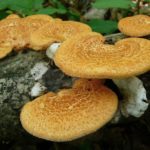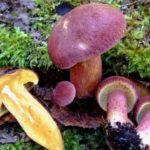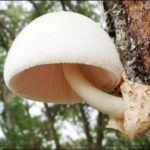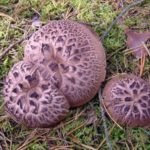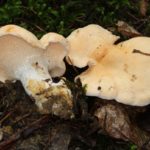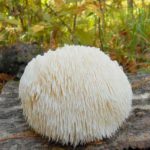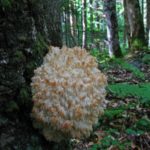Different types of mushrooms often appear on tree trunks and stumps. Their live or dead wood becomes a nutrient substrate for representatives of various fungal species.
Some mushrooms are parasites. They live at the expense of the tree - the donor, gradually expanding destroy living tissue.. Others, settling on dead wood, benefit nature: they process biological material, serve as food for birds and animals, and heal people.
Table of contents
What mushrooms grow on trees?
Microscopic and cap representatives of the biological kingdom of fungi settle on living and dead trunks and fallen trees.
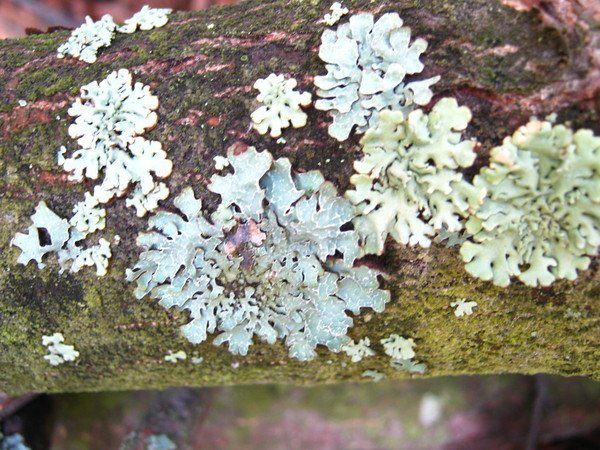
Overgrowths, molds, cup-like formations on the trunk or branches of a tree signal that mushrooms have settled on it. Among them are parasites and symbiotes. The first live off the tree donor, destroying wood. Others create a symbiosis with a tree, receiving vital substances from it and giving the necessary ones to the tree.
The appearance of fungi on garden trees speaks of poor care for garden plantings. In such cases, measures must be taken to save the fruit plantations.
Woods living in the forest, of course, destroy trees. But many of them are edible, good for human and animal health, and can be used for household needs.
The most famous of tree fungi, affecting the garden:
- tinder and their predecessors - blue-green algae on the north-western side of the trunk, the reason - thickening, poor light;
- false tinder, "Lives" on fruit trees, manifests itself as white rot of the core; signs of damage to the stone rocks - dark streaks, dark gray and brown growths on the trunks;
- heart brown rot cherries, pears, and other fruit causes a tinder sulfur-yellow.
- Tinder mushroom
- Tinder false
- Tinder is sulfur-yellow
Some polypores are edible at the stage of milk maturity, but require preliminary heat treatment.
In addition to them, edible polyporus cellular and winter hint, as well as:
- oyster mushrooms;
- deer plumes;
- ryadovka yellow-red;
- Volvariella is silky;
- winter mushroom.
- Oyster mushrooms on old trees
- Winter mushroom
- Plute deer
- Polyporus cellular
- Row yellow and red
- Volvariela silky
One of the most beautiful representatives - black coral, edible mushroom with an unusual, similar to a very light coral, "hat".
Ezhevik coral and its features
Among conditionally edible mushrooms growing on fallen trunks, fallen trees or stumps, blackberries (in some sources - the hedgehog) are coral shaped with an extraordinary fabulous look. This species belongs to macromycetes, that is, to mushrooms with a large and well-developed aerial part.. It is also called Neofits, blackberry latticework, hericia coral and coral fungus.
What it looks like
The mushroom from the family of the guerice is named due to the structure of the fruiting body. Branched, irregularly shaped, with many short (10-20mm) cylindrical "tentacles", it really is very similar to a bush of sea coral. Hanging spines hanging from the main “branches” do not grow longer than 2 cm. Spores form on them. The coral blackberry is attached to the tree substrate with a short leg.
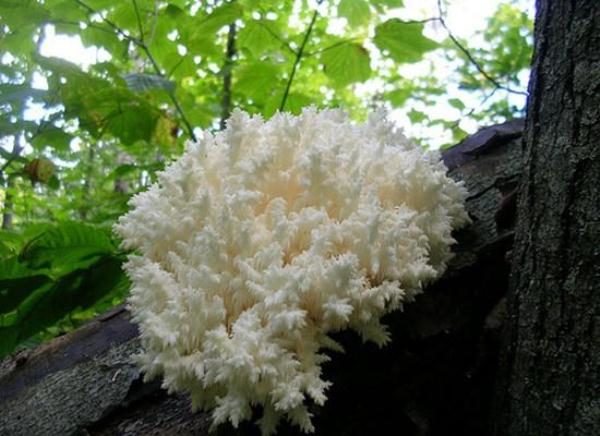
Milky or snow white, pale cream or with a barely noticeable yellowish tint, the open-ended sprawling mushroom is far visible in a darkened gloomy deciduous forest. When ripe, the hc becomes darker, becomes sandy-beige or brown.. With increasing humidity acquires transparency.
On the cut, the pulp of the fungus is fleshy, very light, white, or with a pale pink tint. Smell - pleasant, mushroom, slightly sharp. In the late maturity stage - dark and hard. The dried up coral turns brown.
Adult specimens - champions reach height and width 40 cm. The average value is 30, and in the Siberian forests - 15-25 cm in diameter.
Where and how to grow
It is relatively rare, but The distribution range includes all Russian forests of the temperate climate zone, the Far East and Siberia.. Has long mastered the territory of China, Japan, Kazakhstan, Transcaucasia, Europe and North America.
Grows alone and in groups in deciduous forests. Farther to the north, it chooses fallen trunks and deadwood of aspen and birch, to the south - linden, beech, oak, elm. In mixed and coniferous forests are rarely found. Survives on fallen trees, stumps and fallen trees in old hollows.
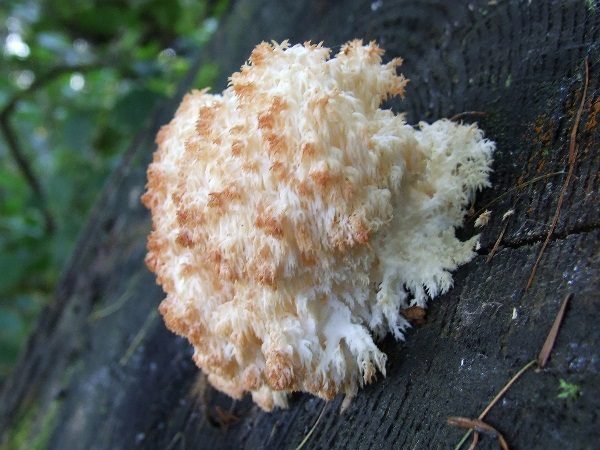
There are legends that in the Middle Ages, coral fungus was not at all rare. But its unusual appearance frightened the mushroom pickers, neofits called the devil's sponge and considered poisonous.
When it matures
Blackberries, like other mushrooms - a perennial organism. But his the fruit body (“hat”) lives one season - from the second half of July to the beginning of October. At this time, the white "coral" and find mushroom pickers.
Similar species
Light branched "bushes" are unique, they are not confused with any other representative of the kingdom of mushrooms.
There are other types of blackberries called:
- blackberries motley (he is a hawk, chicken, kolchak, blackberry scaly and tiled);
- blackberries yellow (he vyemchaty);
- comb blackberries (synonyms - grandfather or mushroom beard);
- Alpine blackberry (or alpine).
- Blackberry Motley
- Blackberries yellow
- Blackberry comb
- Ezhevik Alpine
In appearance, it is most similar to alpine hericia, and in terms of its properties - with comb.
For the blackberry Prialpiy substrate serves fir wood, spruce, at least - pine. This type of hericium is found in mountainous forests, very rarely in the plains.. Sporiferous spikes are located in bunches at the tips of overgrown branches.
The healing properties of blackberry coral
The medicinal benefits of this species of gericia are appreciated. Most of them are due to the presence of phosphorus, calcium, iron, plant proteins, polysaccharides and vitamins.
The pharmacologists of Germany and China have advanced more strongly than others in the study and application of the healing properties.
Medicinal mushroom is used in the treatment and prevention of diseases of the gastrointestinal tract and the entire digestive system.. Polysaccharides protect ulcerated gastric mucosa from gastric acid, stimulate its healing. Stimulate blood flow to the digestive tract and peristalsis. It is a means of preventing oncological processes in the organs of the digestive and excretory systems. The fatty acids contained in the fungus, phenols and five polysaccharides with antitumor activity directly affect cancer cells, the effect is comparable with chemotherapy.
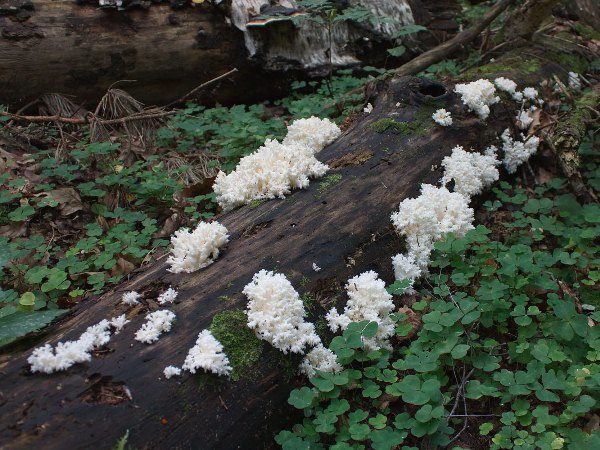
Proven healing effect of blackberries and malignant, and benign education. It blocks the development of cancer of the breast, lung, esophagus, liver, stomachIt is effective in treating pancreatic oncology. It is indicated for varieties of prostate adenoma, cysts, fibromas, pituitary adenomas, myomas. During clinical observations, the tumors resolved or significantly decreased in size.In a comprehensive anticancer therapy reduces the negative effects of treatment.
Improves the functioning of the respiratory organs - bronchi and lungs. Ezhevik beneficial effect on the activation of blood. The positive effect of fungus drugs on the nervous system has been proven, in particular for the treatment and prevention of Alzheimer's disease.
Extracts are used in the fight against diseases of bacterial, fungal and viral and nature.
In folk medicine, tinctures and decoctions are used as anti-depressants.. Used for insomnia and neurasthenia. It is useful for curing impotence, improving metabolic processes and slowing the aging of the body.
How to eat a mushroom?
Interesting unique properties of blackberry coral are used in cooking. Gourmets appreciate rare mushroom for good culinary qualities., an interesting type of a ready dish and the useful properties confirmed by scientific researches.
Coral-like genium is considered conditionally edible.: In cooking, young specimens are used after obligatory pretreatment.As they mature, these mushrooms begin to taste bitter.
Despite the fact that the species is Red Book, in many regions mushroom pickers often find it, harvest it, share cooking recipes and taste sensations. In the national cuisines of other countries, blackberry dishes are also popular with connoisseurs.
Ezhevik stew, fried, boiled, cooked in batter, added to the fillings. For the future harvest by drying, pickling or pickling. Dried use whole or fray in powder.
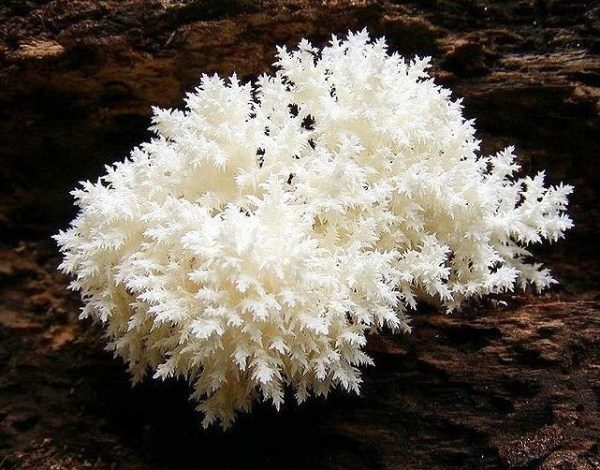
Blackberries gives dishes a delicate flavor. The taste is bright, according to other information - gentle and very pleasant, with a nutty hue. In boiled form to taste and structure resembles the taste of shrimp or squid.
Gourmets are sharing ways to cook coral fungus:
- Gericium fried with spices in butter, add various spices and vegetable garnishes;
- cooked soup, as well as from other mushrooms;
- stir fry in a large amount of vegetable oil;
- add to saladslike other mushrooms.
Ezhevik coral - a beautiful creation of nature. The mushroom has good taste and high healing properties.. In recent decades, the growth areola has expanded, as well as the frequency of blackberry detection. At the same time in Russia the view is under the protection of the state. The task of connoisseurs is to preserve the unique coral mushroom for future generations.
